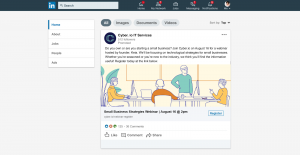Agility Is The New Secret Sauce: How To Boost SEO During The COVID-19 Crisis
There is no denying that the COVID-19 pandemic is impacting all aspects of our lives in the short term and for the conceivable future. Tons of posts are outlining what they believe is happening, and we’re seeing a lot of the same trend — it’s all over the place.
We’ve been here before. During the Great Recession, there was the knee-jerk reaction of many brands cutting budgets, which ended up hurting them months later. In contrast, some brands brainstormed where opportunities existed and how to reach new customers. There are oodles of studies regarding the effectiveness of layoffs, budget pullbacks, and changes in direction that deduce significant statistics:
- Companies cutting investment by 50% for one year before returning to normal budgets take up to two years before recovering lost share.
- Those that increase exposure during a downturn can gain up to 3X more share in the first two years of recovery.
The “TL;DR” of these studies show that pullbacks cause more damage. I’m not arguing against cash flow and protecting your financial war chest, but if everyone is cutting budgets, the ones that don’t will automatically win share of voice.
The last two weeks are not emblematic of where SEO is going in the next month, quarter, or half year. In Slack’s most recent S-1 filing, the company said: “This environment demands an ever-greater ability to adapt and respond. In an increasingly dynamic world, the fundamental business advantage is organizational agility.”
Agility is the new secret sauce.
With all that is going on, we must approach everything with context and empathy. Resources are constrained, and we’re all adapting to new ways of working and communicating.
Here are some tips to consider in order to boost SEO during this time.
Conversion Rate Optimization (CRO)
The premise of CRO is simple — review your signup/checkout/goal process from a customer’s perspective, noting any pain points along the journey to conversion. Does the process require that many steps? Can you reduce the amount of information a customer must wade through to create an account or purchase a product?
The process usually uncovers a number of A/B testing opportunities. What we like most is that CRO impacts all channels, so ROI extends beyond SEO.
Push Forward Development Resources
How many times have you thought: I wish I had some time to devote to X? Now is that time.
Clients are de-prioritizing some big projects, which opens up room to focus on development. Fixing technical SEO issues, pursuing projects that have been put on the back burner, and improving your automation or reporting are all great tasks you can work on, as other daily responsibilities have been put on hold.
Investing in SEO during this pandemic is less about clawing back lost traffic and more about positioning the brand to earn a greater share of voice when the market is back up.
Republish & Promote Content
Re-optimizing, updating, and republishing content you already have has always been a sound practice. These times are no different, and the opportunity is probably greater now considering that more eyes are surfing the internet for a longer period of time.
Organic content is a better way to build user trust than a paid ad ever could be.
It’s the same with creating new content — with a little research, there are no bad investments here. It’s clear that video consumption has grown and doesn’t require a huge production to test into. I predict that people who didn’t watch a lot of video content in the past will change behavior in the long-term.
COVID-19 Content
It’s not fun and glamorous, but customers are asking a lot of questions regarding your brand and this virus. First tip — answer them, even if this means responding with uncertainty. Above all, do not leave them hanging.
Prioritizing content around product delivery, returns, size guides, and lookbooks will give consumers the opportunity to still browse. Some brands are investing in FAQ pages to answer multiple COVID-related questions, and this can be better for overwhelmed customers with inboxes overflowing with emails and news.
Reviewing your keyword reports for terms around “ok google” or “what matches…” will validate lookbooks, size guides, and FAQs, which will continue to pay off in the future.
Experimenting with updatingtitle tags and meta descriptions to highlight changes in policy is another area to explore and test. Lastly, Google My Business shouldn’t be overlooked, as there are a number of COVID-19 specific updates to consider.
Schema, Schema, Schema
The trend has been increasing over the last few years and Schema.org even released special markup for COVID-19. The Schema isn’t going anywhere and is a likely building block for what is next.
Improving your Schema strategy or prioritizing implementation, if you don’t have one, should be a primary focus. With Schema, you will better compete on SERPs you already own, while growing your share of voice and owning more real estate.
AMP Pages
Accelerated Mobile Pages aren’t anything new. They are stored locally on Google’s servers and offer lickety-split page0load speeds. Since it’s a Google product, they prioritize these pages in the index, and they receive a direct rankings boost. AMP is fantastic for news and content, local pages, and even eCommerce.
We have found that the development lift is not as big as many brands think, likely because we have developed and honed a process that maximizes ROI.
AMP might be considered an aggressive strategy, but we have found it pays off every time we do it. I can’t think of a better time to at least test how the technology can be applied to your brand.
In most industries, it will remain difficult to stem the losses as further change continues to occur.
The slower ROI on SEO activities provides an opportunity to level up on user experience, improve technical website health, and leave this pandemic better situated against the competition.
(25)
Report Post





